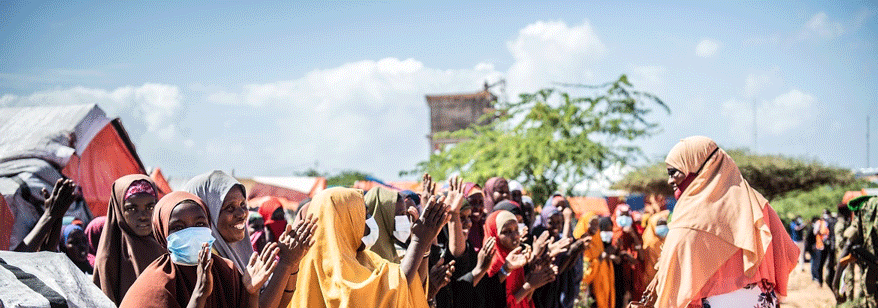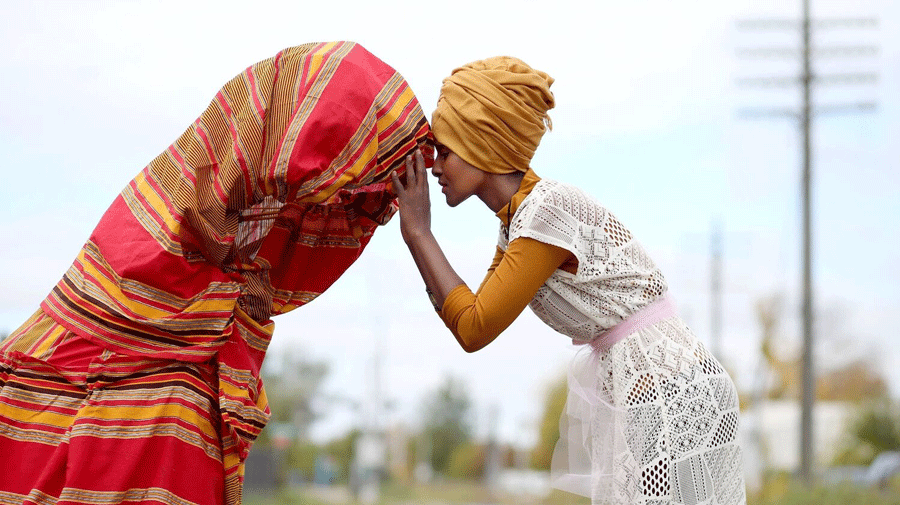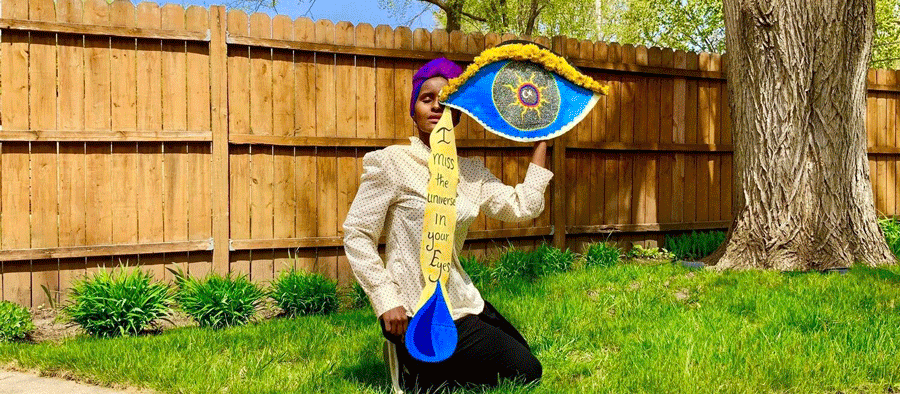In the twilight days of conflict, the importance of nurturing normality and empathy skyrockets to almost unprecedented levels. The persistent instability that conflict and climate disasters cause in an already fragile society can only be balanced by a strong family and cultural foundation. That is the message Somalian refugee, Ifrah Mansour, conveys through her artistic creations.

Somalia has been heavily affected by conflict and climate-based disasters and even though peace and security improved since the formation of the Federal Government of Somalia (FGS) in 2012, the country still confronts recurrent instability. Armed conflict and climate-related crises are triggering further strains on already vulnerable communities—broadening the exponential number of displaced people. According to the Humanitarian Needs Overview for 2022, a total of 7.7 million Somali children, men and women are estimated to require humanitarian assistance.
Leading the conversation, artist Ifrah Mansour explores generational trauma and the refugee experience by uncinching the common perceptions regarding refugees and the African diaspora that still bear unnecessary hardship. The artist fights for Reduced Inequalities and for Peace, Justice and Strong Institutions, two of the United Nations Sustainable Development Goals, by weaving playwriting, performance, poetry, installation and film to capture the complexities of individuals living in countries plagued by war.
Mansour’s acclaimed play, How to Have Fun in a Civil War, brings these complexities to light. In a matter of seconds, you are flooded by the atmospheres of hate and conflict through the lenses of innocence. The seven-year-old main character, played by the artist, details the brief specks of light amid brutal disruption, reenacting the emotional and physical trauma experienced by children during war times and how they make sense of it through youth mannerisms. Mansour turns her childhood experience as a five-year-old living in the midst of Somalia's civil war into tender artistic creation, inviting you to reflect and connect with realities unknown to many.

“The story in How to Have Fun in a Civil War details how children live through a civil war, how children make sense of traumatic times, how children make sense of hate—and how fitting it is right now that children are making sense of the hate that Asian Americans are facing," Ifrah Mansour explains. "Children are making sense of the gun violence African Americans are facing. Children are making sense of what’s happening in Gaza. Violence is a horrible, vicious devil, and it requires multiple artistic mediums to speak of it, to make sense of it, and to inspire people to do something about it.”
By tapping into generational trauma, the artist also explores her own traumatic stories, which motivate her to pursue artistic and educational projects. Her poem I am a Refugee, with deep political roots, depicts the horrible circumstances of war. As war is usually America's course of action, during Trump's administration many families were displaced and asylum seekers turned away due to travel bans. The repetitive words encountered along the poem's body do not only create a rhythmic allure but also reach our empathy levels, making us consider our implications in the current refugee issues.
“Right now, here in Minnesota, the most neglected people are children, veterans who went to these wars, Indigenous folks, people of colour, elders,” the artist states. "You don’t have to look far away at complete strangers. Look at your own community. Neglect breeds more neglect, and lack of empathy breeds more disconnect.”

Connecting heritage with contemporary issues, Mansour creates an intercommunal project entitled Aqal, which is a "true nomadic expression.” A replication of a traditional nomadic hut where the artist lived as a child in a refugee camp. In 2017, having the opportunity to delve into an outdoor art project, in partnership with the elders and activists in Currie Park, Minneapolis, the artist embarked on building her first aqal. As a result of the project, migratory traditions were employed to speak of the current environments of Black and Muslim refugees in America, bringing together several refugees to share stories and get a sense of belonging after facing so much loss.
"Refugees truly understand what it means to find yourself in the middle of nowhere and make a shelter with nothing. Beyond the physical displacement, there is this psychological displacement, yearning to finding a new home that doesn't try to erase you off again," Somalian artist Ifrah Mansour reflects on the current atmospheres regarding refugees and asylum seekers. "There’s enough food and land to feed and house everyone, but there isn’t enough human heart connection to make this happen."
As a Somalian refugee, Mansour is deeply touched by the recurrent struggles individuals and families face when arriving in a new country. Escaping a city or a country under siege and surrounded by war is no easy feat, and artists like Mansour remind us that they should be discussed and awarded, not discarded.
Listen to Ifrah’s beautiful poem, I am a Refugee.
